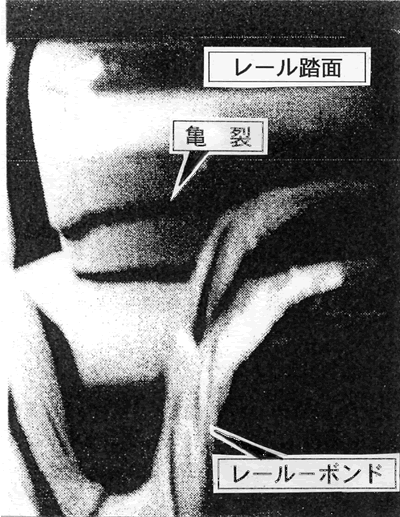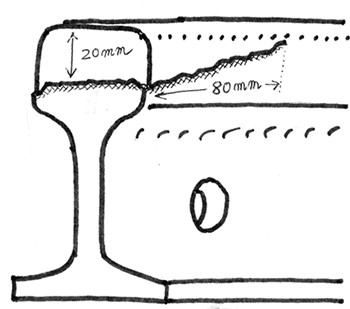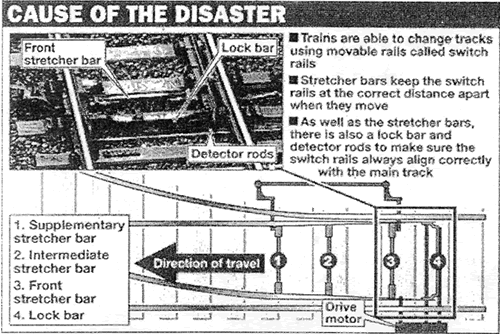

8cm Crack in the Rail at Soga Station
February 28, 2007
 |
 |
8cm Crack in the Rail at Soga Station |
|
(Union News "Daily DORO CHIBA" No.6425,)(Japanes)
|
|
|
||||
|
|
 |
 |
On February 20, the service of 35 up and down trains of the Keiyo Line
were suspended because of cracked rail on the track at Soga station.
The notice of the maintenance of way personnel who found the crack of
8cm length in the rail prevented a serious rail accident. Nevertheless
a terrible condition of rail safety has been exposed to the public.
As is indicated by the photo, the joint of the rail was fractured. The
photo further shows that the crack had almost reached the top of the
rail. By a little more pressure on the rail, the surface of the rail
could have been scraped off for 8cm length and 2cm depth. A fatal derailment
of the train or a collision with another train on the adjoining track
might have taken place.
The maintenance of way personnel, our fellow workers of Kokuro union
members, have confessed they had never before witnessed a crack on the
rail developing in such a violent way. A cracked rail is more dangerous
than a broken rail in that the signal would not alarm when only the
surface of the rail were scraped off by the crack, maintaining the electric
stream on the rail.
It was discovered further that the rail, which has got cracked, was
laid only four years ago. Recent visual inspections (most recently on
February 7) could not detect the crack. Even JR's "cutting edge"
Rail Measurement Train was unable to find out the defect since the crack
has seemingly developed from the bottom to the top of the rail.
Drastic safety measures are needed!
We have currently forced the JR company to replace damaged rails for
60km, while waging safety drive struggle in defiance of company's unjust
punishment, watching and intimidation in the drivers cabs. In spite
of the renewal of rails, fresh defects have been found one after another.
Thus rail replacement seems to require a larger-scale operation than
was expected before. Disclosures of broken rails and cracked rails are
now taking place incessantly. It is really an emergency for rail safety!
The second and the third Amagasaki accidents would be inevitable if
the rails remain as it is today. It is really urgent for rail safety
to stop outsourcing of track maintenance and to hand it back to in house
maintenance, to conduct visual inspection and investigation more often
as before, to finance maintenance of way and necessary personnel for
it much more largely, to reduce traveling speed of trains, to abolish
bolsterless carriages that give intense lateral force to the side of
rail, etc. The JR company should immediately take drastic safety measures
and execute thorough investigation of the cause of current rail defects.
Recent derailment in UK
On February 23 in Lambrigg in northwest England, a serious rail accident
took place. A high-speed train derailed and rolled down the side of
steep embankment. Its cause is reported to be drop-off of stretcher
bars and bolts to fix them. Network Rail, a track operator company that
has undertaken the business as a result of railway privatization, has
admitted it.
Though the casualties were miraculously small with one person killed
and 22 passengers hospitalized, the train driver got his neck bone gravely
fractured. UK medias comment the accident, saying, "Engineering
experts said further fatalities were prevented by the strength of the
carriages. This accident actually highlights the engineering advances
that have been made over the past few years to maintain the structural
integrity of trains and keep passengers safe."
Just imagine how serious the fatalities might have been if the carriages
had been made of extra-light stuff as in Japan as a result of rationalization
policy. Though the train traveled at a high speed of 151mph (95mph),
the basic structure of the carriages, as is shown in the photos, remain
unchanged. It was a difference from the case of the Amagasaki accident,
in which the rolling stock became a heap of scrap iron.
 |
Inevitable result of railway privatization
Brother Bob Crow, general secretary of RMT, remarked the derailment
as follows:
"It is bad enough that there are still contractors, sub-contractors,
labour-only agencies and one-man-and-a-trolley outfits let loose on
the tracks under Network Rail.
"Handing the track network to the private sector was bad enough
when it was done by a single organization, but splitting it up and handing
it to a host of operators whose sole aim is to make a profit would be
a recipe for further disaster.
"Trains and tracks should be operated by the same organization,
but that organization should be publicly owned and controlled.
"Network Rail's chief executive Armitt told that all Network Rail's
track maintenance and inspection work is carried out in-house. The reality
contradicts his claim. In fact, Network Rail has current contracts with
private engineering firms. The company is intentionally failing to fill,
and freezing, vacancies in a bid to cut costs, preferring to farm the
work out to contractors. As many as 60,000 on-Network Rail workers,
from a myriad of private firms, have access to the trackside as part
of their job. In many cases Network Rail has no idea who these workers
are."
Thus the latest derailment in Lambrigg in UK took place as an inevitable
result of the privatization and outsourcing.
Just Like JR company also in UK
 |
In 2002, seven passengers died in a derailment at Potters Bar, north
of London. Its cause was insufficient condition of the turnout. Moreover,
two years earlier four people were killed in a derailment at Hatfield
near London.
In UK, rail maintenance system is apparently collapsing as a result
of privatization. Also in the operation of the Japan Railway Companies
similar thing is happening. We cannot overlook this situation. No fight,
no safety. It is now imperative that the struggle for safe drive against
rationalization (or labor-saving and outsourcing) should be strengthened.
In the hearing on Amagasaki accident
The Accident Investigation Committee of the Land, Infrastructure and
Transportation Ministry (LITM) published last December a Draft Report
of Fact-finding Mission on Amagasaki accident and held a hearing on
February 1, 2007 to draw up a final report. The vice-president of the
Japan Railway West, who was summoned to the hearing, shamelessly justified
company's faulty practices, saying, "Nikkin Kyoiku -Daily disciplinary
lesson (lengthy and humiliating re-training sessions for workers "responsible"
for delays or overrunning stops and so on) is totally right", "Delay
of installing ATS (Automatic Train Stop) was inevitable since its deliberate
preparation needed much time" and "Normal drive can easily
keep our schedule though you call it overloaded".
Even the members of the Accident Investigation Committee of the LITM,
which is also responsible for the Amagasaki accident for its de-regulation
policy, was obliged to comment that the insistence of the JR West was
a evasion and recommend that the JR West withdraw it.
It goes, however, further. Executive members of the three unions of
railway workers, i.e. National Railway Workers Union (Kokuro), Japan
Railway Trade Unions Confederation (JR Rengo) and Japan Confederation
of Railway Workers Unions (JR Soren), of JR West Company were also called
to attend the hearing. Mr. Asano, one of the speakers of the bereaved
of the Amagasaki accident, who spoke in the hearing, commented the statement
of the union leaders:
"None of the responsible persons of the three concerned unions
at the hearing referred to the rail safety problem. Both of labor and
management of the JR West are totally rotten."
130 kmph traveling speed planned on Joban Line!
Nothing differs in the JR East Company from the JR West. The East
Company is currently planning to run the trains with the traveling speed
of 130 kmph in the Joban Line. Such a high speed is unprecedented for
local lines in the whole Japan. The reason, according to the company,
is to compete with the "Tsukuba express", rapid train running
parallel to the Joban Line. We wonder what at all they have learned
from the terrible tragedy of the Amagasaki. Exactly the same faulty
policy is going to be practiced only after two years of the accident,
while their regret on the negligence of rail safety is still fresh in
our memory. The Joban Line is not an elevated railroad. There are naturally
numerous crossings on the tracks. The JR East Company totally neglects
the serious problems that inevitably arise from overloaded travel schedule,
which requires high-speed and sudden change of acceleration and slowdown,
putting the train drivers under extreme nervous tension.
When we allow the things develop in this way, another Amagasaki accident
would inevitably happen. We must act immediately. Let's fight the labor
spring offensive 2007 as a struggle for safe drive against capital's
rationalization with a demand of enforced drastic safety measures!
![]()
|
|
|
|